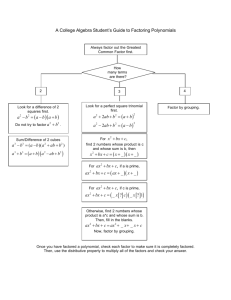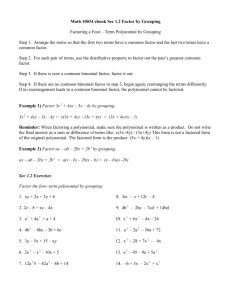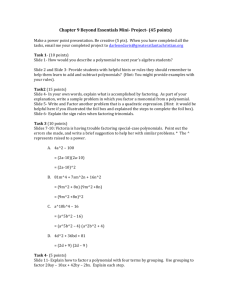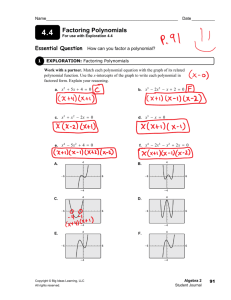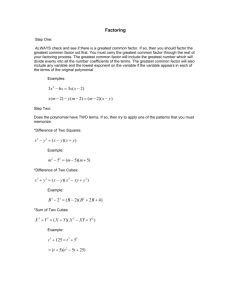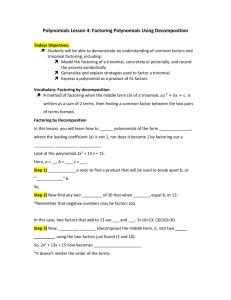ac Method of Factoring Polynomials
advertisement
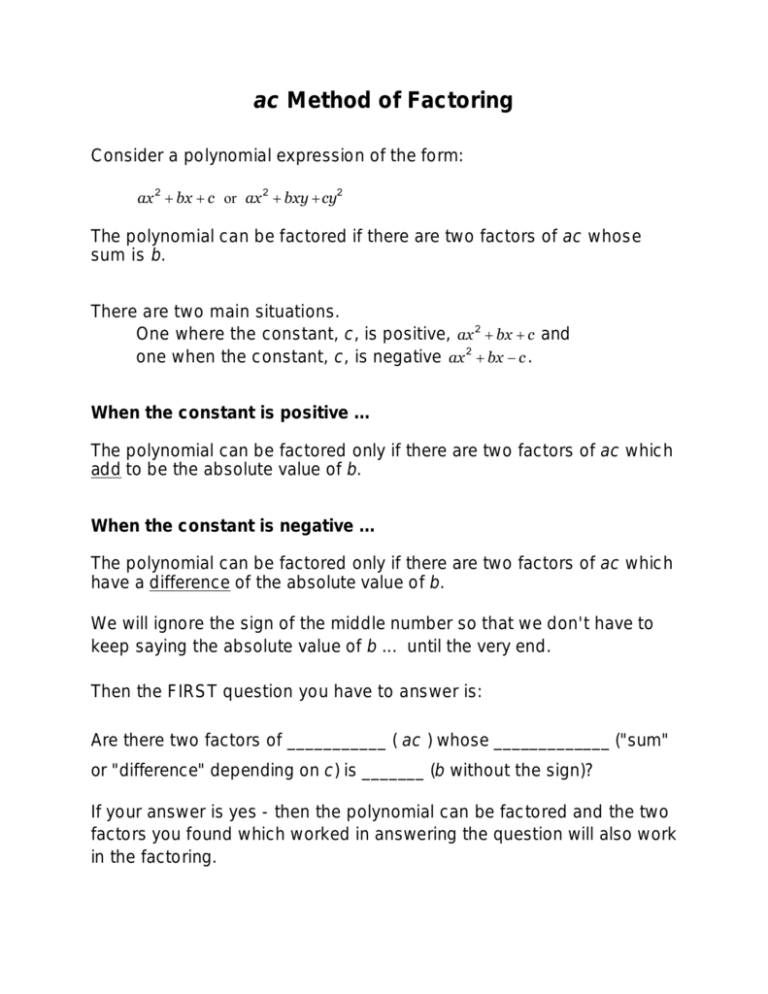
ac Method of Factoring Consider a polynomial expression of the form: ax 2 + bx + c or ax 2 + bxy + cy2 The polynomial can be factored if there are two factors of ac whose sum is b. There are two main situations. One where the constant, c, is positive, ax 2 + bx + c and one when the constant, c, is negative ax 2 + bx − c . When the constant is positive ... The polynomial can be factored only if there are two factors of ac which add to be the absolute value of b. When the constant is negative ... The polynomial can be factored only if there are two factors of ac which have a difference of the absolute value of b. We will ignore the sign of the middle number so that we don't have to keep saying the absolute value of b ... until the very end. Then the FIRST question you have to answer is: Are there two factors of ___________ ( ac ) whose _____________ ("sum" or "difference" depending on c) is _______ (b without the sign)? If your answer is yes - then the polynomial can be factored and the two factors you found which worked in answering the question will also work in the factoring. Examples 1. 3 + 11a + 6a2 The First Question: Are there two factors of 3•6 = 18 whose sum (because the last number is positive) is 11 ( the middle number) ? Yes, 2 and 9. Rewrite the original problem and factor by grouping. 3 + 11a + 6a2 = 3 + 9a + 2a + 6a2 = 3(1 + 3a) + 2a(1+ 3a ) (rewrite 11a as 9a + 2a largest first and same sign as the original middle number) (notice the common factor (1 + 3a)) = (3 + 2a)(1+ 3a) 2. 2x 2 + 7x − 15 The First Question: Are there two factors of 2•15 = 30 whose difference (because the last number is negative) is 7 (the middle number) ? Yes, 10 and 3. Rewrite the original problem and factor by grouping. 2x 2 + 7x − 15 = 2x 2 + 10x − 3x − 15 = 2x (x + 5) − 3(x + 5) (rewrite 7x as 10x - 3x largest first and same sign as the original middle number) (notice the common factor (x + 5)) = (x + 5)(2x − 3) Note: The last two examples say "Notice the common factor". This is not a coincidence! If you can answer yes to the question, it will factor in this method. 3x 2 − 5x + 4 3. The First Question: Are there two factors of 3•4 = 12 whose sum (because the last number is positive) is 5 (the middle number - ignore the sign) ? Factors of 12 are ... • 1 and 12, sum = 13 • 2 and 6, sum = 8 • 3 and 4, sum = 7 Since there is not a factor pair whose sum is 5 the problem won't factor, write "prime". 4. 600 − 800t − 800t 2 Simplify the polynomial by factoring the Greatest Common Factor (GCF) first. ( = 200 3 − 4t − 4t 2 ) The First Question: Are there two factors of 3•4 = 12 whose difference (because the last number is negative) is 4 (the middle number - ignore the sign) ? Yes, 6 and 2. Rewrite the original problem and factor by grouping. ( 200 3 − 4t − 4t 2 ) ( = 200 3 − 6t + 2t − 4t 2 ( ) (rewrite 4t as –6t + 2t largest first and same sign as original middle number) ) = 200 3(1 − 2t ) + 2t (1 − 2t ) (notice the common factor (1 – 2t)) = 200(3 + 2t )(1− 2t ) 5. 300 + 400t − 400t 2 Simplify the polynomial by factoring the Greatest Common Factor (GCF) first. ( = 100 3 + 4t − 4t 2 ) The First Question: Are there two factors of 3•4 = 12 whose difference (because the last # is negative) is 4 (middle number - ignore the sign) ? Yes, 6 and 2. Rewrite the original problem and factor by grouping. ( 100 3 + 4t − 4t 2 ) ( = 100 3 + 6t − 2t − 4t 2 ( ) (rewrite 4t as 6t – 2t largest first and same sign as original middle number) ) = 100 3(1 + 2t ) − 2t (1 + 2t ) (notice the common factor (1 + 2t)) = 100(3 − 2t )(1+ 2t ) Exercises For each trinomial below, write the complete process of factoring them. Use the steps given in the previous models as your guide. Trinomial Factors 1. 2x 2 − 9x + 9 (2x − 3)( x − 3) 2. 20y2 + 38y + 12 2(5y + 2)(2y + 3) 3. 12a2 + 9a − 30 3(4a − 5)(a + 2) 4. 4x 2 − 23x + 15 (4x − 3)( x − 5) 5. 3r 2 − 8r − 16 (3r + 4)(m − 4)


